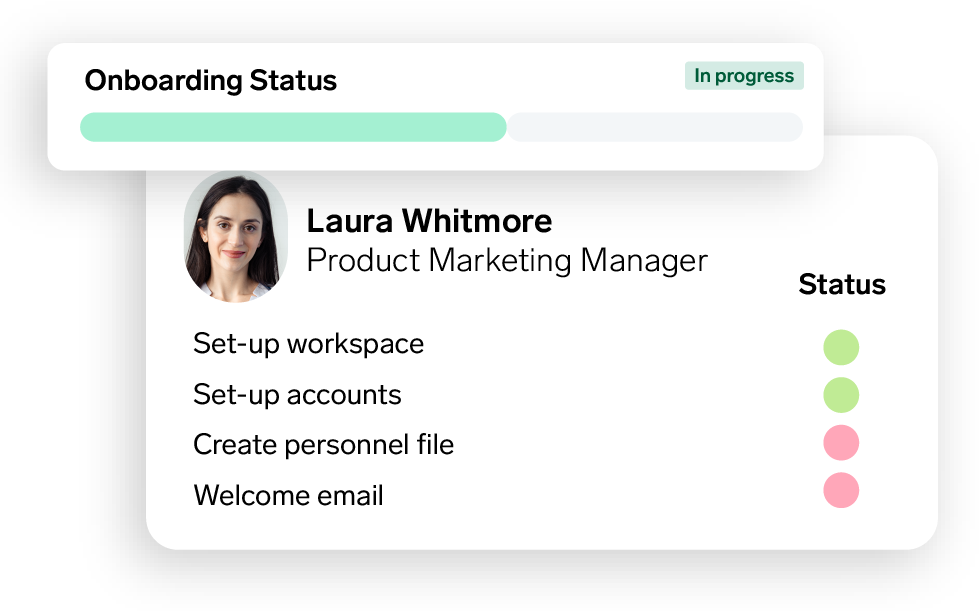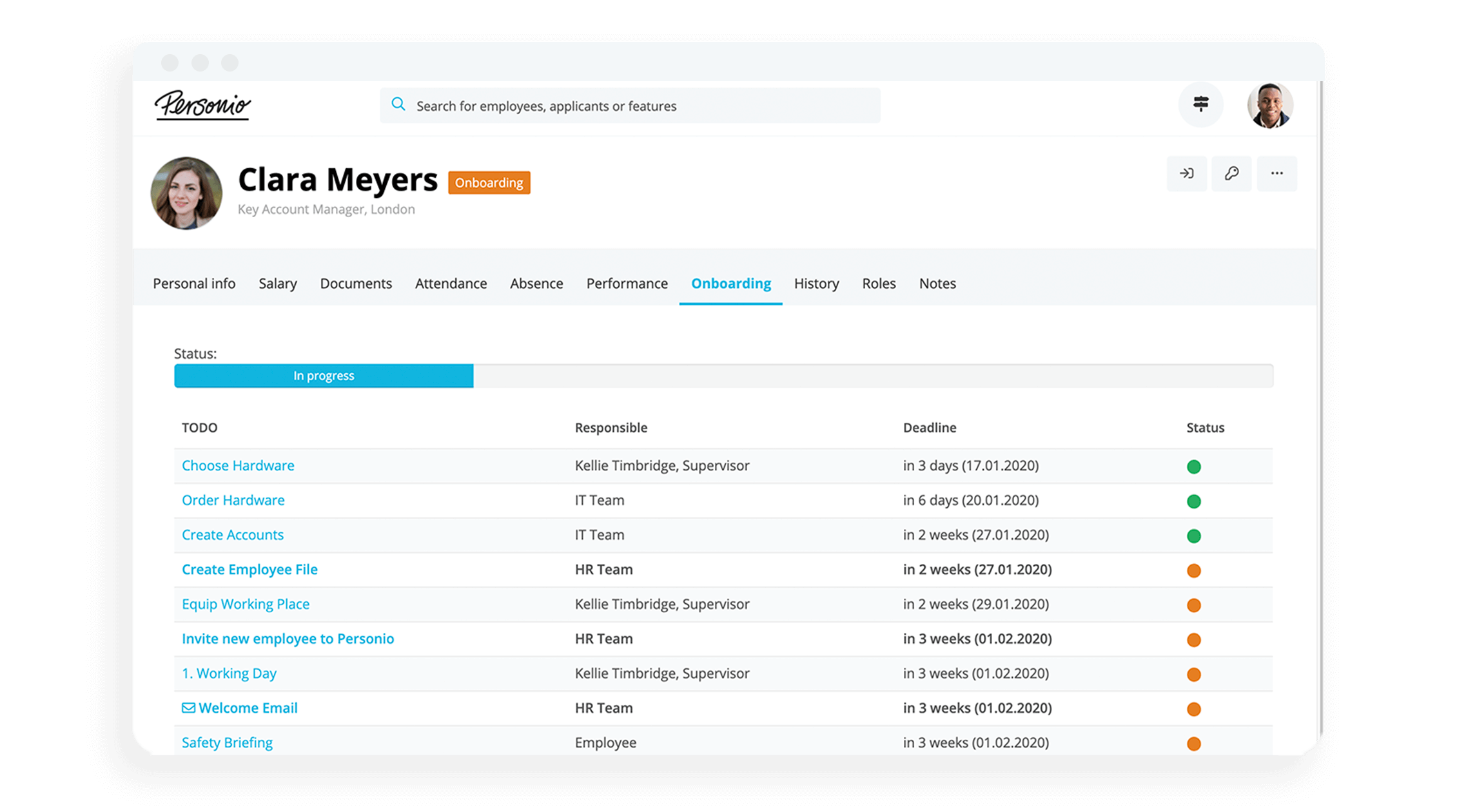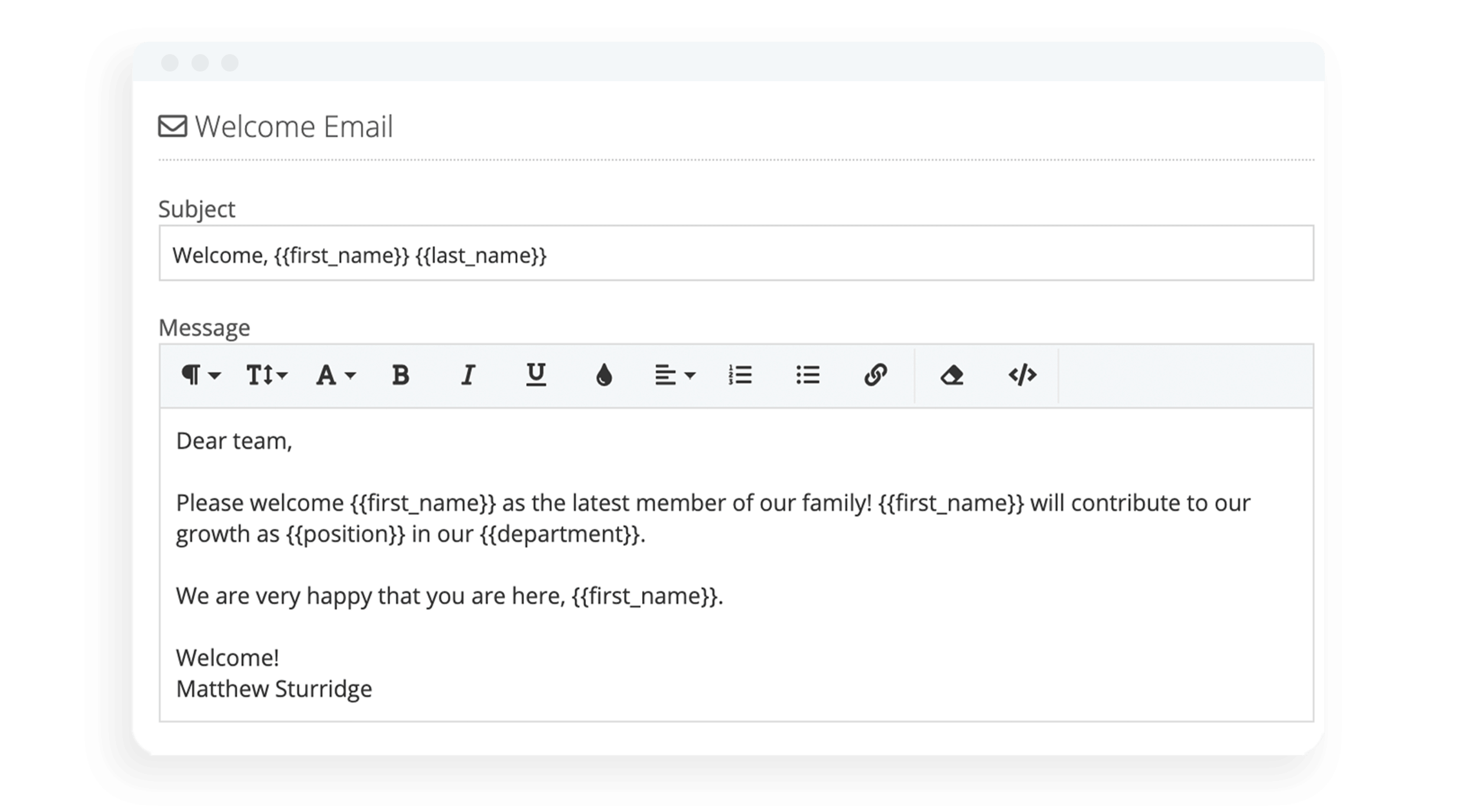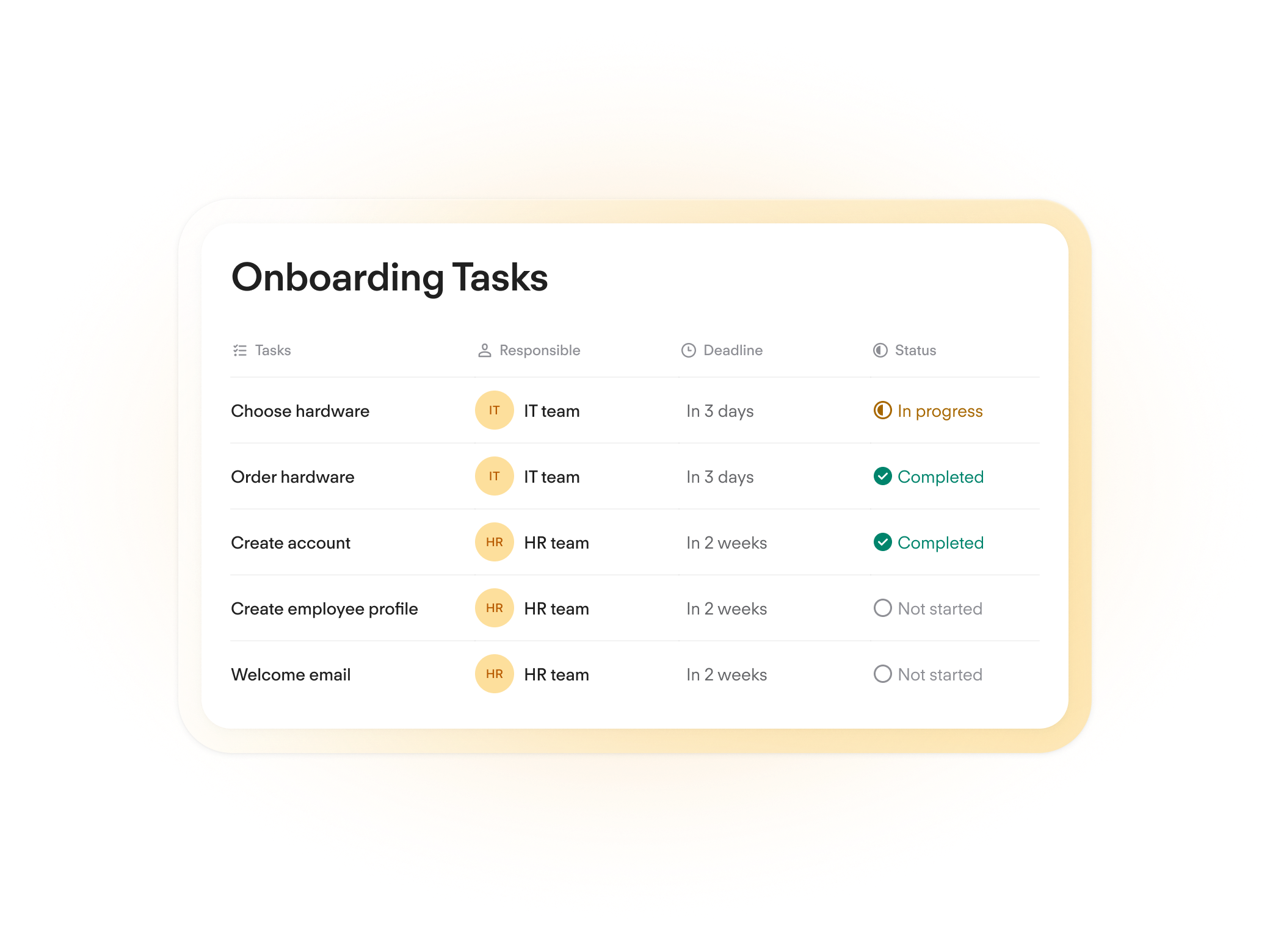
Improve employee onboarding
Discover strategies to enhance your employee onboarding process for a smoother transition.
Read our guideLatest Blog Posts
How to Write a New Employee Introduction Email (+ Templates)

Whenever a new employee is starting out on their first day, a new employee introduction email to your team should be first on the docket. That's because while an email introduction may seem simple, the impact it can have is anything but.
In this article, we offer a how-to on properly phrasing a new employee introduction email to a team or to colleagues. Consider it as part of your overall onboarding process, which Personio can help optimise with an entire range of features.
Why it’s important to send an introduction email to colleagues
A new workplace, new tasks and new colleagues: The first day of a new job can bring with it an absolute flurry of changes. That’s why for any new employee, your HR team needs a host of processes designed to welcome them.
By having a new employee introduction email to the team in place, you instil the feeling that your new colleague is valued from their very first day. Then, current staff members are kept up-to-date when new team members arrive, speeding up the introduction phase and helping them integrate more easily and with greater efficacy. Simplify the process with our employee induction checklist today.
That’s why this phase of employee onboarding is so crucial. New colleagues need to be integrated into the team quickly, all while conveying a sense of belonging to keep spirits high.
But let’s back it up with some concrete examples. Here are three additional reasons why new employee introduction email to teams are so crucial:
1. Employees are more satisfied and motivated
A warm reception sets the stage for the rest of the onboarding process. It signals to newcomers that in your company, people treat each other with respect, show interest in one another and are valued. This helps to increase employee motivation right from the beginning.

2. Social integration is sped up
Feeling accepted by your new colleagues is one of the most critical aspects of onboarding. So being able to quickly integrate them into the team helps new employees establish an internal network right away.
From there, they can immediately feel a tangible sense of connection with their new colleagues. And the more people feel accepted, the more productive they become. That’s because they feel more comfortable asking questions and are ready to perform at their best.
3. They enhance your corporate image
A decisive advantage comes with the perfect start. Your employees will be even more pleased to have joined your company – and this will contribute to your reputation as a best-in-class employer.
In a best-case scenario, new employees will even share their positive experiences with their friends or post them to sites like Glassdoor. This kind of positive feedback can be invaluable for your employer brand.
Organise more than just welcome emails

Gather all of the data you need so you can focus on making your new hire feel welcome with our easy-to-use checklist.
Get it freeHow do you write a new employee introduction email to teams?
The email should be short and personal while making all of the information visible at a glance. Using bullet points to highlight the most important information is completely fine when introducing new colleagues, too.
Here are the most important components, followed by our helpful sample templates:
Salutation
You can address the introduction email to both the new employees and the entire team. It depends on your preference:
Do you want to introduce new employees to their colleagues?
Or would you prefer to speak directly to the new employee(s)?
Overall, it doesn’t matter which option you choose. In both cases, you’ll be sending the email to the entire team or to selected departments (not just to an individual).
Photo
By including a photo, you give a face to the new employee’s name. This helps current staff build a connection between the two, providing a cue to quickly remember new employees.
Name, title, department
This information might seem basic, but it is imperative. It will help your current employees understand where new colleagues fit into the company structure.
Previous experience
Should you include where new employees have worked before? Sometimes, companies like to rely on new employees to share where they have worked with their entire time.
This helps current employees contextualise colleagues in a professional sense. But, rarely will a new colleague have the entire company as an audience to share where they have been and what they have learned.
So it helps to provide a bit of information to tell a new employee’s story about where they have been. Try and answer some of the following (where it makes sense):
Where has the new employee worked before?
What positions have they held?
Is it possible that they have worked with similar people?
Personal information
It also helps to include a smattering of personal details. This could include a new employee’s hometown, hobbies or their favourite travel destinations. This helps your staff get to know their new colleague beyond their title, making it easier for them to start up a casual conversation (especially in the first few weeks).
From an onboarding perspective, this also helps your new employee. They will feel a bit less pressure to strike up conversations or to try and relate with new colleagues, as their colleagues will already know enough about them to start a conversation of their own. It results in smoother, friendlier and more effective connections.
How do you get this kind of information easily? This is an area where HR software can help. You can make questions like these a task in the onboarding process and then incorporate the answers directly into the introduction email.
Contact information
Conclude an introductory email by providing contact information for the new colleague. This way, current staff get all of the most important information in one single message.

Top tips for announcing a new team member
Start small: The first order of business is to introduce new employees to their own teams. For good reason, these should always be done in person (if possible) and in as much depth as possible. This is also true for colleagues from other departments that will frequently interact with your new employee.
Build from there: To a certain degree, a personal introduction to all of the other employees is also appropriate. This should include a tour of the company, where you show all new employees how to find their way around the offices and where you can quickly introduce them to the other teams.
Make a splash: To a certain degree, a personal introduction to all of the other employees is also appropriate. This should include a tour of the company, where you show all new employees how to find their way around the offices and where you can quickly introduce them to the other teams.
Introduce with care: Ideally you should email the team a few days ahead of the new employee's start date, sharing the reason for the new hire, when they will begin, their professional background and what you hope they will achieve. You may want to include a link to their professional profile on LinkedIn and encourage your team to connect once they begin.
Try and be specific: To direct colleagues, explain what will be the new employee's main focus areas will be and how you hope they specifically will be working with the team included in the email.
Be proactive: If you can to introduce the new employee to these teams so that they are known to these colleagues ahead of their first meeting together. You can suggest a coffee with the new employee to explain some of these projects they will be collaborating on and to give them a 'who's who' of stakeholders.
Consider the sender: Even though an HR manager should be handling the process, the introduction email should come from your CEO. This showcases to new employees that they are not simply valued by their new team. Rather that their presence is welcome from the very top-down. It helps build a connection (or a psychological contract, as it is also known).

New employee introduction email templates
We’ve put together a collection of introductory emails to new colleagues for you to use in your own company.
More importantly, we have outlined three distinct approaches you can take. Feel free to try each of these out to see which is most effective for your team and which matches the types of company culture you have…
Template 1: the personal approach
Hey everyone,
I've got a very special announcement. Today, we're welcoming [Employee Name] as a [Title] to the team. Let's give them a big welcome!
[Insert Photo]
To help you all get to know [Employee Name], here are a few key facts:
Where are you from or based? [Answer]
What do you like to do in your spare time? [Answer]
What is your favourite musical artist? [Answer]
We are happy to have you here, [Employee Name]. We hope you get off to a fantastic start!
[Name]
Template 2: the formal approach
Hello everyone,
Today, our new colleague, [Employee Name], is starting as a [Title].
[photo]
[Employee Name] comes to us with many years of experience and will help us take some giant steps towards achieving our corporate goals as a [Title].
We are delighted that they are joining us, and we wish them a great start.
A warm welcome to you, [Employee Name]!
[Name]
Template 3: the direct approach
Hello [Employee Name],
Welcome to [Company Name]!
We are very pleased that you’ve become a member of our team.
We wish you all the best as you get started with us and we look forward to working with you.
Kind regards,
[Name]
Useful templates, automated processes, more effective HR
Even with templates, introduction emails can become a time-consuming task. Manually personalising them and sending them out can take hours. But with HR software, the effort can be reduced, because the entire process is automated.
Here’s how we do it at Personio in our onboarding process:
Introduction emails are sent as a standard element of onboarding. All new employees are given a task to upload a photo of themselves on their first day.
Our People & Workplace Team came up with five questions that new colleagues are invited to answer about themselves.
Once both tasks have been completed, an introduction email will automatically be sent to all colleagues on behalf of our CEO.
This entire process is streamlined and automated to make it easier both for employees and for our HR department to help introduce new colleagues to their teams (and the team at large).
It’s also easily done all within the Personio software, as our 10,000+ customers can attest to, so we can help do the same for your organisation. Click the button to learn more about how Personio can help.
